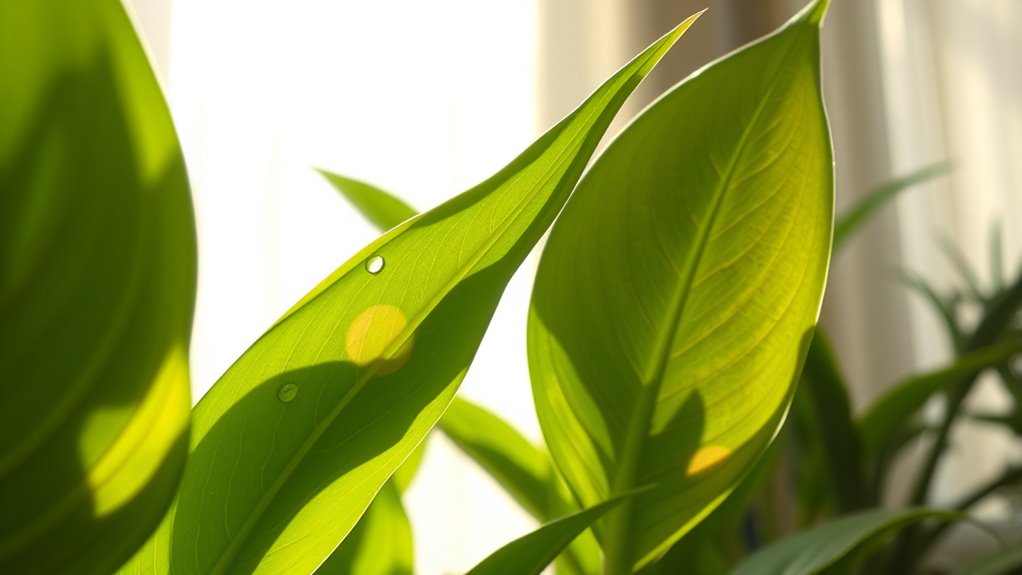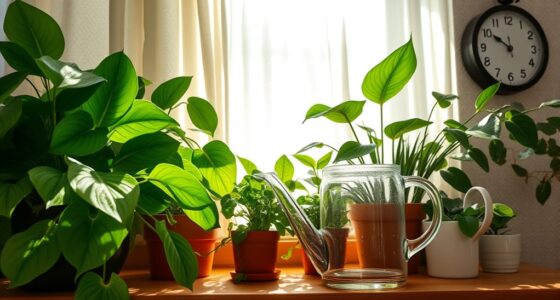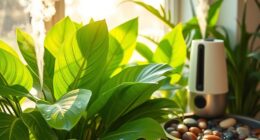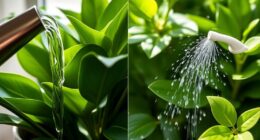To prevent sunburn on indoor plant leaves in summer, position them away from direct sunlight or use sheer curtains to diffuse the light. Adjust their placement seasonally, especially near south- or west-facing windows. Maintain consistent watering to help plants recover if they get sunburned, and regularly check for pests that can weaken plants. Proper light management keeps your plants healthy and resilient, so exploring more tips can help you keep your indoor garden thriving.
Key Takeaways
- Position plants away from direct sunlight or use sheer curtains to diffuse intense rays.
- Adjust plant placement seasonally to prevent overexposure during summer months.
- Maintain consistent, well-balanced watering to help plants recover from sunburn and reduce stress.
- Monitor and manage sunlight levels, especially near south- or west-facing windows, to prevent leaf scorch.
- Regularly inspect for pests and overall plant health to boost resilience against sun damage.
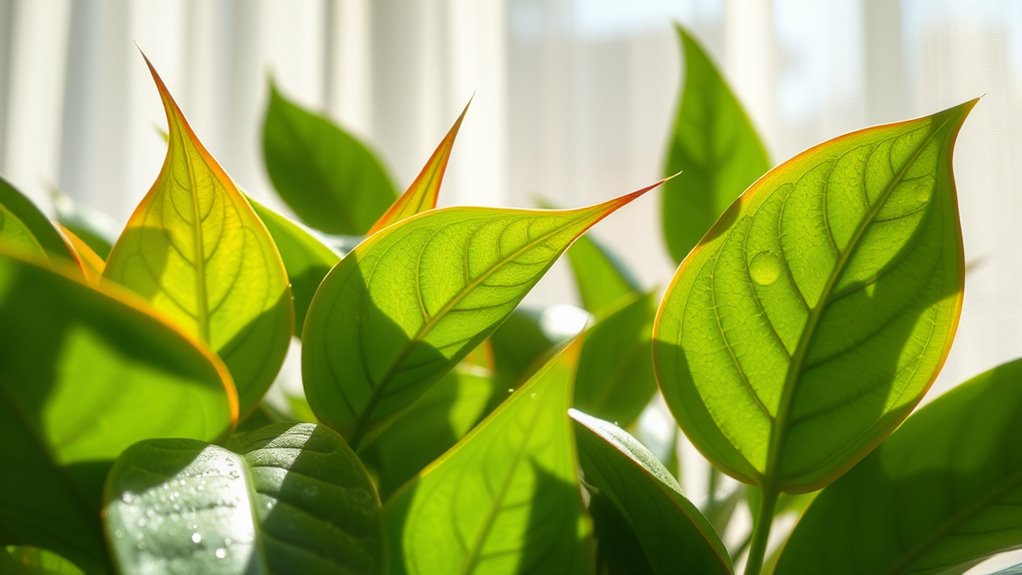
Indoor plants can suffer from sunburn even when kept inside if they’re exposed to direct sunlight through windows. The harsh rays can scorch their leaves, leading to brown, crispy patches that tarnish their appearance and weaken the plant’s health. To prevent this, it’s essential to understand how sunlight interacts with your indoor environment. Positioning your plants away from direct sunlight or using sheer curtains can diffuse the light and protect delicate leaves. Keep an eye on the intensity of sunlight during summer months, especially in rooms with large south- or west-facing windows, where the sun is strongest. Adjusting the location of your plants based on the season can go a long way in avoiding sunburn.
Consistent watering schedules play a significant role in maintaining your plant’s overall health and resilience against sun damage. When plants are well-hydrated, they’re better equipped to recover from minor sun stress or burns. However, overwatering can lead to issues like root rot, which weakens the plant’s ability to transport nutrients and water to its leaves. Striking a balance and sticking to a watering schedule tailored to each plant’s needs helps keep them strong and less susceptible to damage. Remember, the goal is to keep the soil evenly moist but not soaked. Check the soil regularly and adjust watering frequency based on the season, humidity, and the specific plant species. Maintaining healthy foliage also involves understanding light interaction, which influences how leaves respond to environmental conditions.
Pest management also plays an essential part in protecting your indoor plants from sunburn and subsequent damage. Pests like spider mites and aphids can weaken leaves and make them more vulnerable to sunburn by causing stress and leaf discoloration. Regularly inspecting your plants and removing pests early prevents further damage and reduces the likelihood of sunburn-related issues. Using natural remedies or targeted insecticides can help keep pests at bay. Additionally, stressed plants—whether from pests, improper watering, or too much sun—are more prone to damage. Ensuring your plants are healthy overall makes them more resistant to sunburn and other environmental stresses.
Frequently Asked Questions
Can Artificial Lighting Cause Sunburn on Indoor Plants?
Artificial light can cause sunburn on indoor plants if the light intensity is too high, especially with powerful LED grow lights. You might not realize it, but intense artificial lighting can scorch leaves just like direct sunlight. To avoid this, keep LED grow lights at an appropriate distance and use adjustable settings. Monitoring your plants’ response helps prevent sunburn, ensuring healthy, vibrant leaves indoors.
How Does Humidity Affect Indoor Plant Sunburn Risk?
Imagine your indoor plants basking in a humid greenhouse. High humidity levels reduce plant transpiration, making leaves less able to cool themselves and more prone to sunburn. When humidity is low, plants lose moisture quickly, increasing stress and damage risk. You can protect your plants by maintaining balanced humidity levels, ensuring they stay hydrated, and reducing their vulnerability to sunburn caused by environmental stress.
Are Certain Plant Species More Prone to Sunburn Indoors?
Certain plant species are more prone to sunburn indoors because of their shade tolerance and leaf sensitivity. You’ll notice plants with low shade tolerance, like succulents and ferns, suffer more from direct sunlight, leading to leaf damage. Conversely, shade-tolerant plants, such as pothos or snake plants, handle bright spots better. To protect your plants, observe their leaf sensitivity and adjust lighting accordingly, preventing sunburn and keeping them healthy.
Can Outdoor Sun Protection Methods Be Adapted for Indoor Plants?
Did you know that 60% of indoor plant owners struggle with sunburn? You can adapt outdoor sun protection methods like shade cloths and reflective surfaces for your plants. Shade cloths reduce direct sunlight, while reflective surfaces bounce light away, preventing leaf damage. Use these techniques indoors to keep your plants healthy and vibrant, especially during summer’s intense sun. It’s a simple way to mimic outdoor protection and avoid sunburn.
Does the Color of Indoor Plant Pots Influence Sunburn Susceptibility?
You might wonder if pot color affects your indoor plants’ sunburn risk. Dark-colored pots absorb more heat, increasing the chance of leaf damage from the sun’s rays. Light-colored pots reflect heat, helping keep your plants cooler. To protect your indoor plants, choose light-colored pots in sunny spots, and monitor how much heat your pots absorb, especially during summer, to prevent leaves from getting sunburned.
Conclusion
By taking these simple steps, you can save your indoor plants from sunburn, transforming your space into a lush oasis rather than a scorched wasteland. Remember, neglecting sun protection could turn your thriving greenery into a mere shadow of its former self—an almost tragic loss. Stay vigilant, adjust your sunlight exposure, and treat any damage promptly. With care, your indoor plants will flourish brighter than a summer sunrise, bringing endless beauty and vigor into your home.

